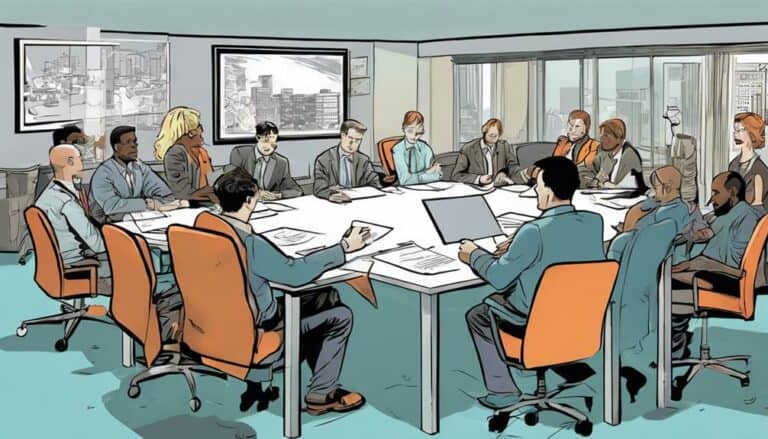You might think traditional team building activities and leadership development programs are similar in fostering team cohesion, but the differences are more significant than you realize.
From building immediate connections to cultivating long-term growth, each approach plays an important role in shaping team dynamics.
By understanding these distinctions, you can effectively tailor your strategies to nurture a cohesive and high-performing team.
Key Takeaways
- Traditional team building enhances short-term relationships, while leadership development cultivates long-lasting leadership skills.
- Leadership development programs focus on sustained team unity through individual empowerment and collective leadership growth.
- Assessments in leadership programs improve team dynamics and conflict resolution for tailored training sessions.
- Balancing team building and leadership development ensures holistic team cohesion and sustained effectiveness.
Key Variances Between Traditional Team Building
The key variances between traditional team building activities and leadership development programs lie in their distinct focuses and long-term objectives. Traditional team building activities primarily concentrate on enhancing team cohesion through activities aimed at improving relationships and communication within the team. These activities are often event-based and designed to create a positive atmosphere for teamwork in the short term.
On the other hand, leadership development programs are structured to target individual and collective leadership skills, fostering strategic thinking and enhancing overall team performance. These programs have a longer-term focus, aiming at sustained growth and development of leadership capabilities within the team. While traditional team building activities offer immediate results in team cohesion, leadership development programs contribute to long-lasting improvements in team dynamics and effectiveness.
Impact of Leadership Development on Team Cohesion
To understand the impact of leadership development on team cohesion, consider how shifting the focus from traditional team building activities to structured leadership programs elevates individual leadership skills, thereby fostering sustained unity and effectiveness within the team.
Leadership development programs concentrate on enhancing individual leadership capabilities, which in turn positively influence team cohesion. Unlike traditional team building activities that emphasize group dynamics, leadership development programs prioritize the growth of each team member's leadership skills. Through tailored coaching and feedback, these programs enable individuals to lead effectively, consequently strengthening team cohesion.
While traditional team building activities may enhance morale and communication, they often lack the targeted approach necessary for individual leadership growth. By empowering leaders to guide and support their teams competently, leadership development programs play an important role in establishing sustainable team cohesion.
This strategic shift towards individual leadership growth within a team setting greatly contributes to the overall effectiveness and harmony of the team.
Assessing Team Cohesion in Development Programs
Fostering team cohesion in development programs requires targeted training and coaching sessions to enhance relationships, trust, and communication among team members. Assessments play a vital role in evaluating team cohesion by examining team dynamics, conflict resolution skills, and collaboration effectiveness.
These assessments provide valuable insights into the strengths and areas for improvement within the team, guiding the development of tailored training sessions to address specific needs. By conducting regular assessments, development programs can track progress in enhancing team cohesion and identify any challenges that may arise.
Additionally, assessments help in measuring the impact of the training sessions on team dynamics and collaboration. Through a combination of targeted training sessions and thorough assessments, development programs can effectively strengthen team cohesion, leading to improved overall performance and success.
Continuous feedback and support further reinforce team cohesion, creating a supportive environment for growth and development.
Strategies for Effective Team Building Activities
How can team building activities strategically enhance relationships and communication within a team to foster a sense of unity and camaraderie among team members?
Effective team building activities are designed to promote open communication, encourage leadership skills, and strengthen the bonds between team members. To achieve this, incorporate exercises that require active listening, problem-solving, and collaboration. Icebreakers help break down barriers and create a comfortable environment for sharing ideas. Trust exercises build confidence and reliance on one another, enhancing teamwork. Problem-solving challenges push individuals to think collectively and develop innovative solutions. Effective team building activities also provide opportunities for emerging leaders to showcase their skills and for others to learn from them.
Balancing Team Building With Leadership Development
Balancing team building activities with leadership development programs is essential for fostering a holistic approach to enhancing team cohesion and effectiveness.
Team building activities lay the foundation by improving relationships and communication within the team in the short term. These activities create a positive atmosphere for teamwork, instilling trust and camaraderie.
However, leadership development programs offer a more sustained approach to growth and success in the long term. These programs focus on enhancing individual and collective leadership skills, fostering strategic thinking and ensuring long-lasting team effectiveness.
Conclusion
To sum up, while traditional team building activities focus on immediate benefits like improved relationships and communication, leadership development programs prioritize long-term strategies for enhancing skills and overall team effectiveness.
By balancing both approaches, teams can achieve sustained growth, deepened skills, and strategic thinking that fosters long-term cohesion and success.
Embracing the differences between traditional team building and leadership development is key to creating a cohesive and high-performing team.

